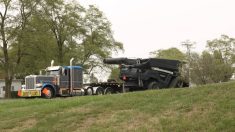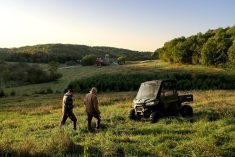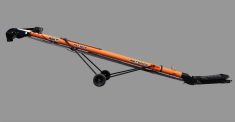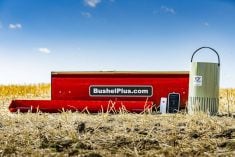What were most farmers thinking as they watched DOT, the autonomous implement platform, perform for seemingly never-ending crowds during the Ag in Motion farm show in July? It’s hard to say if it was amazement, excitement that field robots are finally here, or some combination of the two.
Whichever it was, DOT, the brainchild of SeedMaster president Norbert Beaujot, made its unexpected debut at that show. The autonomous implement platform had been a well-kept secret that was in development for three years, and seeing this machine come from a short-line manufacturer rather than a major brand was arguably even more unexpected.
“I call it my retirement project,” said Beaujot when speaking to Grainews. “It’s my hobby. It’s my passion.”

It’s still too early to draw conclusions, but that hobbyhorse — or 163 horses of Cummins diesel power — might be the machine that spearheads the next major shift in dry-land farming.
Built on a scale designed to fit into the current equipment fleets of commercial farmers, DOT will be the first fully autonomous machine to work Saskatchewan fields in a really meaningful way — as part of normal farming operations. Six “hand-picked” producers who the company feels they can work with will get a chance to incorporate a DOT into their seeding operations next season as part of the initial rollout ahead of a full commercial release.
“They’ll be people we know we can work with on the evolution of the product through the first year,” said Beaujot. “It’s exciting. It was hard to not talk about it, because I’ve kept this confidential for a lot of years. Finally, a few weeks ago we could say, ‘OK, this is what we’re coming out with.’”
DOT uses a U-shaped chassis that is designed to quickly connect to any compatible implement.

“It gives us the ability to load very quickly, having the centre of gravity or weight loaded directly on the platform,” he added. “Compared to a tractor we gain large efficiencies, because you have to weight the tractor up so that it has traction, whereas here it utilizes the implement or the grain in the harvest cart as part of its traction power.”
SeedMaster engineers designed a new, single-row tool bar seeder to mate with DOT. But DOT is not a one-trick pony; it can perform multiple functions. The company showed not only the drill, but sprayer and grain tank bodies as well, which means the robot can work throughout the growing season at a variety of tasks.
In fact, Beaujot says so far he has envisioned 104 different implement bodies that DOT could be equipped with.
When determining the best the size for DOT, Beaujot said he designed it to fit well with existing farm equipment. The seed drill body has a 30-foot working width, and he says that proved to be the most efficient working width. The brand has also created a sprayer attachment that uses a 60-foot boom
“This is a 30-foot seeder and a 60-foot sprayer,” Beaujot said. “So with a 30-foot seeder we tram line for the sprayer.”
For easy on-road transport, DOT’s wheels pivot allowing it to travel sideways, reducing its transport width to just under 12 feet (3.61 metres).

“It has a 163-horsepower Cummins diesel engine with hydrostatic drive and auxiliary pumps,” explained Greg Vennard, engineering manager at SeedMaster, adding that it can work at speeds from creeping to nine or 10 m.p.h.
“It’s controlled through software that we’re developing and that does all of the autonomy,” he explained. “So you have an app on your laptop and that’s where you’re controlling your machine from. The laptop can be in your half ton in the corner of the field.”
Producers can keep track of DOT’s progress in real time through the signal to that computer, and it will report any problems it may encounter.
“We have Lidar sensors on it for detecting obstacles that come into the field you didn’t plan for, like if Dad parked his half ton in the way,” he said with a chuckle. “It communicates back to the laptop to say I’m stuck, there’s a mechanical failure of some kind, I’ve lost communication, or my sensors have seen an obstruction we didn’t account for. It will stop and send a signal back to the operator, and it’s up to the operator to come and diagnose the problem.”

Although a final decision has not yet been made on what type of sensors, or combinations of them, future versions will use.
Going forward, SeedMaster has created an independent company, DOT Technologies, that will further develop and manufacture DOT machines.
“Seed Master has a good name and its focus is on no till, metering and seed and fertilizer placement,” said Beaujot. “But there are so many broader applications for the Prime Mover that we thought we’d create a new company and open it up to all manufacturers to develop DOT-ready implements.”
















